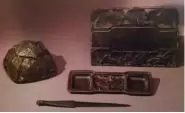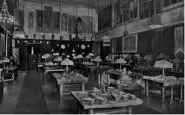A Closer Look Into the World of Tiffany Studios

From the Desk of Brittany Spencer-King
Louis C. Tiffany (1848- 1933), the son of Tiffany and Company co-founder, Charles Lewis Tiffany (1812-1902), is one of the most critically acclaimed and well-known decorative artists and businessmen from the turn of the twentieth century. Known mainly for his work in glass, Tiffany devoted his life to creating works of art for the private and public sector. These objects range from stained-glass windows and vases to lighting fixtures, desk sets, and other objects of art. Tiffany’s business ventures were fueled by his combination of talent, desire and entrepreneurship, which gave way to some of the most celebrated works of the period. A number of scholars have published in-depth analyses of Tiffany’s work in glass as well as provided an overview of his other works. However, there is still more that can be said about Tiffany and his many business ventures. Here I will explore one such venture – Tiffany Studios’ bronze and brass desk sets. These desk sets, or fancy goods, made up the bulk of his line of decorative and functional objects for consumption by the wealthier classes.
It is not surprising that Tiffany began a line of metal luxury goods. During his youth, he spent time with Edward C. Moore (1827-1891), a skilled metalworker and the head of design at Tiffany and Company. Tiffany’s early relationship with Moore likely fueled his interest in the applied arts and laid the groundwork for his later career. Additionally, Tiffany was an avid collector of metal objects such as tsubas, or Japanese sword guards, Near East metal bowls and plaques, as well as American and European decorative accessories. Desk sets were becoming increasingly popular around the time that Tiffany started his metal production. Indeed, a New York Times article on the growing popularity of parlor writing desks from the same period states: “The artistic possibilities of the parlor desk are great. The inkstand should be elegant…and fancy may run riot in pens, pen racks, pen wipers, paperweights, seals, wax and tapers.” Many articles such as this one were published at the turn of the twentieth century and helped to further solidify the popularity of desk sets. In addition, numerous firms were already manufacturing desk accessories and retailers, such as Tiffany and Company and Sears, Roebuck and Company, begun to sell these goods. There is no doubt that Tiffany was aware of this push for luxury writing accessories and he began to encouraged his designers to produce small objects such as inkwells, candlesticks, boxes and tea screens, to help keep his staff fully employed year round. This was the beginning of the “fancy goods” line. From here, Tiffany further expanded his hold on carriage trade objects, or objects that cater to the wealthier classes, to include glassware, leaded-glass lampshades, ceramics, and other metal household objects.
Tiffany’s desk sets and the fancy good line started after Tiffany realized the demand for small luxury objects. However, Tiffany’s Studios could not produce these items on site and these metal objects were sent to a commercial company to be manufactured. As stated in an article from Studio International, “It may be mentioned in passing that the metal workshops were first started, because it was found impossible to get manufacturers to carry out the designs given.” To better control production of his metal wares, Tiffany opened his own metal foundry on the same land as his Corona, Queens’ glass factory in 1897. The line quickly became a way to keep the furnaces active and profitable during the hot summer months when the number of commissions for large windows and mosaics declined. These objects were produced in a wide variety of designs, which included extensive handiwork with glass inlays or additions, and utilized the skills of the workers as well as the materials already being used at the factory. The desk sets were produced in at least twenty-one different patterns from the early years of the foundry to its closing in the 1920s.
 There are several methods that can be used to cast metal objects; however, sand casting was the standard method of metal molding at the turn of the twentieth century. This method is easy to identify because it leaves a grainy texture on the metal. Sand casting starts with a plaster mold of the original object model. The plaster mold is then pressed into a rectangular box, called a drag, which is filled with coarse, moist sand. Then a fine grain sand, called French sand, is used to create a piece mold around the exposed parts of the plaster mold. Additionally, a second rectangular box, called a cope, is fitted to the top of the drag and bolted together. The box is then inverted, and the process repeated. The mold is then complete, and the plaster mold must be removed.
There are several methods that can be used to cast metal objects; however, sand casting was the standard method of metal molding at the turn of the twentieth century. This method is easy to identify because it leaves a grainy texture on the metal. Sand casting starts with a plaster mold of the original object model. The plaster mold is then pressed into a rectangular box, called a drag, which is filled with coarse, moist sand. Then a fine grain sand, called French sand, is used to create a piece mold around the exposed parts of the plaster mold. Additionally, a second rectangular box, called a cope, is fitted to the top of the drag and bolted together. The box is then inverted, and the process repeated. The mold is then complete, and the plaster mold must be removed.
The drag, cope, and core are then baked for twelve hours until the sand is hard. Then all the pieces are assembled, and the metal is poured. Once the bronze is cooled the cope and drag are removed, and excess sand is removed with a brushed. The object is then removed from the mold and any protruding pieces of metal are cut away, and the metal is polished. The piece is now ready for any additions in the form of patination, enamels, or chasing. In Tiffany’s case, the desk sets received brown or green patination, gold plating, and several different applications of glass work in the for or enameling or the insertion of glass jewels or sheets.
With these methods, Tiffany was able to produce a large quantity of desk sets and other fancy goods in a relatively short period of time. The firm soon started to produce a wide variety of patterns to suit any taste. Check back next week for a sampling of patterns and the factors that inspired them.
Have research you would like to share with our readers on a particular facet of the Arts and Crafts Movement or Revival? Please email us at [email protected]. We’d love to hear from you!
For a complete list of photo credits and sources cited please email us at the above address.

